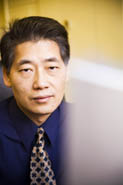Better living through (green) chemistry
Better living through (green) chemistry McGill University
User Tools (skip):
Better living through (green) chemistry

Professor C.J. Li is working on a process that will enable us to use waste CO2 to create polymer plastics.
CLAUDIO CALLIGARIS
Alchemists, the pre-scientific ancestors of modern chemists, placed lead and gold into a kind of spiritual opposition, and in their quest to transform the one into the other, to transmute lead into gold, they sought not only riches, but spiritual enlightenment and the secrets of life itself.
Today, a purely scientific but strangely similar transformation is occurring, one focused on a different set of opposing principles: toxic and green. McGill researchers are leading the global charge to transmute the way we do chemistry itself. In the lab and on the shop floor, zero-emission green chemistry is beginning to replace traditional practices that rely on non-renewable petrochemicals and toxic organic solvents. Moreover, many of these new practices are often vastly more efficient than the ones they are replacing. Unlike the alchemists and their ultimately futile quest, green chemists may actually have found their philosopher's stone.
"Chemistry is the only field whose basic mandate is to make new forms of matter," says Professor Bruce Lennox, chair of McGill's Chemistry Department. "No other field has that as its primary mandate. And in order to invent new molecules, you need to have a chemical reaction that you understand and can implement."
Over the last two centuries, traditional chemistry learned to create those reactions, primarily with non-renewable petrochemicals and highly toxic and flammable organic solvents like benzene, toluene and tetrahydrofuran, explains Professor Chao-Jun (C.J.) Li PhD'92, Canada Research Chair in Green Chemistry and one of the pre-eminent researchers in the field. However, with increasing concerns about their effects on the environment and on public health, these practices are increasingly being seen as unsustainable.
The water cure
Just this month, a study published in The Lancet said that exposure to industrial chemicals may underlie a "silent pandemic" of childhood brain disorders like autism and attention deficit hyperactivity disorder. Other recent studies point to increasing contamination of ground water with toxic organic compounds and the pollution of both land and sea with plastic waste that will last for centuries.
Dr Li and his colleagues, however, have recently developed possible solutions to both problems. The first is a method to replace toxic organic solvents in many chemical reactions with water, something that would have been unthinkable as recently as 15 years ago.
"People have rarely looked at using water in organic chemistry at all," says Dr Li. "Some industries are still using chemical reactions that were discovered over a century ago." Using water as a solvent not only vastly reduces toxic waste products, he explains, it actually makes the processes far more efficient, and thus very interesting from an economic standpoint.
Dr Li's second important discovery is a new process that he predicts will make it possible to create polymer plastics from CO2. This has multiple commercial and environmental benefits, not the least of which is the elimination of petrochemicals and toxic solvents from the plastics-making process. It also has huge implications for that other environmental bogeyman, global warming. "Some people want to bury waste CO2 to reduce its greenhouse effects but it's far more efficient to turn it into something useful. This new plastic has extremely good properties, and another big advantage, it's biodegradable. If people throw it out, it decomposes and becomes CO2 again."
Charge of the green brigade
McGill's rise to the forefront of green chemistry began during the tenure of Professor Emeritus Tak-Hang (Bill) Chan, Dr Li's doctoral advisor and a pioneer in the field. The University is now a global green chemistry leader, the core institution of Canada's Green Chemistry Network and a magnet to researchers the world over. There are now eight faculty involved in green chemistry at McGill, including Professors Bruce Arndtsen, Karine Auclair, Nicolas Moitessier and Marcus Lindström, who was recently recruited away from Sweden's Lund University. Dr Audrey Moores will also be joining McGill in January 2007, after completing her post-doctoral studies at Yale University.
Lennox, whose primary field is nanomaterials, credits his green chemistry colleagues for creating an environment that encouraged him to explore other possible applications of his existing research. He discovered that gold nanoparticles, which he was applying primarily to biomedical problems, also acted as an excellent catalyst for using methanol as a fuel. This has tremendous implications for the creation of methanol-based fuel-cells and the struggling Quebec forestry sector, which is seeking new markets for its products.
Lennox notes the parallels between green chemistry and preventative medicine, saying, "Preventing a problem is far more satisfactory than trying to fix one."

